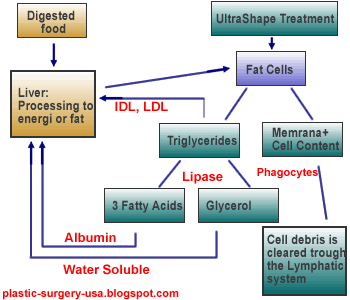Fat Cell Clearance during Ultrashape(ultrasonic)
Fat is nature’s way of storing excess energy. Fat is efficient in storing energy as it takes up very little space and does not require water when stored in a cell. Up to 70% of the volume of fat cells is occupied with what we call fat.
When fat tissue is treated by the UltraShape(ultrasonic) device, the focused ultrasound beam is directed towards a specific area within the fat. The ultrasound wave causes mechanical disruption of the membranes of the fat cells, sparing the blood vessels, peripheral sensory nerves and connective tissue. Since the effect is focused to a specific depth, overlaying skin is not damaged.
WHAT HAPPENS TO FAT AFTER ULTRASHAPE TREATMENT?

The presence of large amounts of triglycerides, in interstitial fluid compartments, has no natural correlate. When outside the fat cell, triglycerides are normally packaged in discrete lipoprotein particles – a combination of apolipoproteins and lipids, cholesterol, triglycerides, and cholesteryl esters. A series of metabolic pathways direct the trafficking of water insoluble molecules of cholesterol and triglyceride through the water-based circulatory system and to the interstitial fluid space1. During the passage through the arteries and interstitial space, lipoprotein-bound triglycerides are catabolized to free fatty acids and glycerol molecules.
There is little or no animal or clinical data describing the distribution and temporal processing of free triglycerides released from traumatized adipocytes. The only clinical correlate may be trauma cases of massive areas of soft tissues (car accidents, burns, etc).
This discussion focuses on the interstitial compartment and the metabolism of triglycerides, free fatty acids and glycerol. It is well established that interstitial fluid compartments contain lipoproteins, biological signals and chemical analytes that all interact and engage cells through cell surface membrane receptors or processes (phagocytosis, etc). The kinetic features of the interstitial compartment are now being understood for normal analyte, as about 42% of the total body water is extracellular.
When fat tissue is treated by the UltraShape(ultrasonic) device, the focused ultrasound beam is directed towards a specific area within the fat. The ultrasound wave causes mechanical disruption of the membranes of the fat cells, sparing the blood vessels, peripheral sensory nerves and connective tissue. Since the effect is focused to a specific depth, overlaying skin is not damaged.
WHAT HAPPENS TO FAT AFTER ULTRASHAPE TREATMENT?

The presence of large amounts of triglycerides, in interstitial fluid compartments, has no natural correlate. When outside the fat cell, triglycerides are normally packaged in discrete lipoprotein particles – a combination of apolipoproteins and lipids, cholesterol, triglycerides, and cholesteryl esters. A series of metabolic pathways direct the trafficking of water insoluble molecules of cholesterol and triglyceride through the water-based circulatory system and to the interstitial fluid space1. During the passage through the arteries and interstitial space, lipoprotein-bound triglycerides are catabolized to free fatty acids and glycerol molecules.
There is little or no animal or clinical data describing the distribution and temporal processing of free triglycerides released from traumatized adipocytes. The only clinical correlate may be trauma cases of massive areas of soft tissues (car accidents, burns, etc).
This discussion focuses on the interstitial compartment and the metabolism of triglycerides, free fatty acids and glycerol. It is well established that interstitial fluid compartments contain lipoproteins, biological signals and chemical analytes that all interact and engage cells through cell surface membrane receptors or processes (phagocytosis, etc). The kinetic features of the interstitial compartment are now being understood for normal analyte, as about 42% of the total body water is extracellular.